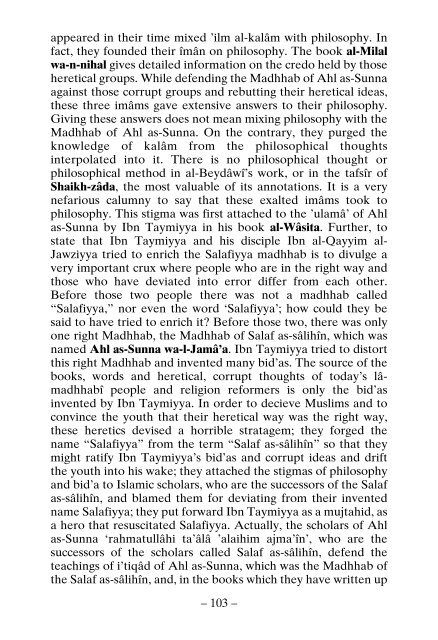Belief and Islam
BELIEF AND ISLAM star This work, Belief and Islam, originally was written in Persian under the title I’tiqâd-nâma by Hadrât Mawlânâ Khâlid al-Baghdâdî, a profound ‘âlim of Islam and a specialist in ma’ârif of tasawwuf. Hâji Faydullah Effendi of Kemah, a khalîfa of great walî Mavlânâ Mahmûd Sâhib, the brother of the author, translated the book into Turkish and named it Farâid-ul-fawâid which was printed in Istanbul in 1312 A.H.[1894]. Our bookstore had it translated again from the Persian original into Turkish and, some explanations and three chapters, published it with the title Imân ve Islâm in 1966. German, French and Arabic versions are also published by our bookstore. This book, explains five fundamentals of Islam, six fundamentals of îmân and the contemporary information about the matter and refutes those who are against Islam and those who are lâ-madbhabî.
BELIEF AND ISLAM
star This work, Belief and Islam, originally was written in Persian under the title I’tiqâd-nâma by Hadrât Mawlânâ Khâlid al-Baghdâdî, a profound ‘âlim of Islam and a specialist in ma’ârif of tasawwuf. Hâji Faydullah Effendi of Kemah, a khalîfa of great walî Mavlânâ Mahmûd Sâhib, the brother of the author, translated the book into Turkish and named it Farâid-ul-fawâid which was printed in Istanbul in 1312 A.H.[1894]. Our bookstore had it translated again from the Persian original into Turkish and, some explanations and three chapters, published it with the title Imân ve Islâm in 1966. German, French and Arabic versions are also published by our bookstore. This book, explains five fundamentals of Islam, six fundamentals of îmân and the contemporary information about the matter and refutes those who are against Islam and those who are lâ-madbhabî.
You also want an ePaper? Increase the reach of your titles
YUMPU automatically turns print PDFs into web optimized ePapers that Google loves.
appeared in their time mixed ’ilm al-kalâm with philosophy. In<br />
fact, they founded their îmân on philosophy. The book al-Milal<br />
wa-n-nihal gives detailed information on the credo held by those<br />
heretical groups. While defending the Madhhab of Ahl as-Sunna<br />
against those corrupt groups <strong>and</strong> rebutting their heretical ideas,<br />
these three imâms gave extensive answers to their philosophy.<br />
Giving these answers does not mean mixing philosophy with the<br />
Madhhab of Ahl as-Sunna. On the contrary, they purged the<br />
knowledge of kalâm from the philosophical thoughts<br />
interpolated into it. There is no philosophical thought or<br />
philosophical method in al-Beydâwî’s work, or in the tafsîr of<br />
Shaikh-zâda, the most valuable of its annotations. It is a very<br />
nefarious calumny to say that these exalted imâms took to<br />
philosophy. This stigma was first attached to the ’ulamâ’ of Ahl<br />
as-Sunna by Ibn Taymiyya in his book al-Wâsita. Further, to<br />
state that Ibn Taymiyya <strong>and</strong> his disciple Ibn al-Qayyim al-<br />
Jawziyya tried to enrich the Salafiyya madhhab is to divulge a<br />
very important crux where people who are in the right way <strong>and</strong><br />
those who have deviated into error differ from each other.<br />
Before those two people there was not a madhhab called<br />
“Salafiyya,” nor even the word ‘Salafiyya’; how could they be<br />
said to have tried to enrich it? Before those two, there was only<br />
one right Madhhab, the Madhhab of Salaf as-sâlihîn, which was<br />
named Ahl as-Sunna wa-l-Jamâ’a. Ibn Taymiyya tried to distort<br />
this right Madhhab <strong>and</strong> invented many bid’as. The source of the<br />
books, words <strong>and</strong> heretical, corrupt thoughts of today’s lâmadhhabî<br />
people <strong>and</strong> religion reformers is only the bid’as<br />
invented by Ibn Taymiyya. In order to decieve Muslims <strong>and</strong> to<br />
convince the youth that their heretical way was the right way,<br />
these heretics devised a horrible stratagem; they forged the<br />
name “Salafiyya” from the term “Salaf as-sâlihîn” so that they<br />
might ratify Ibn Taymiyya’s bid’as <strong>and</strong> corrupt ideas <strong>and</strong> drift<br />
the youth into his wake; they attached the stigmas of philosophy<br />
<strong>and</strong> bid’a to <strong>Islam</strong>ic scholars, who are the successors of the Salaf<br />
as-sâlihîn, <strong>and</strong> blamed them for deviating from their invented<br />
name Salafiyya; they put forward Ibn Taymiyya as a mujtahid, as<br />
a hero that resuscitated Salafiyya. Actually, the scholars of Ahl<br />
as-Sunna ‘rahmatullâhi ta’âlâ ’alaihim ajma’în’, who are the<br />
successors of the scholars called Salaf as-sâlihîn, defend the<br />
teachings of i’tiqâd of Ahl as-Sunna, which was the Madhhab of<br />
the Salaf as-sâlihîn, <strong>and</strong>, in the books which they have written up<br />
– 103 –

















